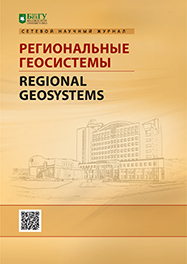Application of geoinformation systems when carrying out the cadastral assessment of real estate objects in the Russian Federation
The reported study was funded by RFBR and the Administration of the Krasnodar Territory, project number 19-410-230062.
DOI:
https://doi.org/10.18413/2712-7443-2020-44-1-55-63Keywords:
cadastral valuation, real estate, valuation object, GIS, MapInfo, QGISAbstract
Geographic information technology has now established itself in various fields of application. The advantages of their use, especially in the cadastral valuation, on the outcome of which the relationship between the taxpayer ̶ the owner of the property and the tax receiver – the municipality depends, are undeniable. However, the role and importance of automating the processes of analysis and questions of the implementation of the stages of cadastral valuation in the entire system of cadastral valuation and taxation of real estate are not fully disclosed in the scientific literature. For many types of spatial operations used at different stages of the cadastral valuation, the end result is the presentation of data in the form of thematic maps and plans, supplemented, if necessary, by reporting documents, three-dimensional images, graphs, charts and tables, photographs and other means. In this regard, the possibilities of using GIS during cadastral valuation were considered, among which were calculations of the values of pricing factors, estimated zoning of the territory, and others. The analysis of reports and draft reports on the results of the state cadastral valuation of land plots and capital construction objects in the land of settlements was carried out. The main directions of the use of GIS in the regions in the framework of determining the cadastral value of valuation objects are identified. At the initial stage of the cadastral assessment should be used GIS. GIS is a multifunctional information system designed to collect, store, analyze and graphically visualize spatial data and related information about the necessary objects, which allows you to combine, organize and display on the map relevant and reliable data from various information systems. The most used are MapInfo and QGIS. The most important GIS functionalities in the field of assessment are identification of objects of assessment, determination and calculation of pricing factors, estimated zoning of the territory, georeferencing of objects of cadastral assessment, transformation of coordinate systems. The article substantiates the possibility of using GIS in carrying out cadastral valuation, including the calculation of the values of pricing factors, estimated zoning of the territory, and others. The regions using digital thematic maps for real estate assessment, as well as regions using the functionality of geographic information systems were identified.
Downloads
References
Грибовский С.В. 2017. Оценка стоимости недвижимости: Учебное пособие. 2-е изд., испр. и доп. М., ООО «Про-Аппрайзер» Онлайн, 472 с.
Массовая оценка. Электронный ресурс. URL: http://pkmo.ru/pkmo/ (дата обращения: 14 ноября 2019).
QGIS. Электронный ресурс. URL: https://qgis.org/ru/site/ (дата обращения: 14 ноября 2019).
MapInfo. Электронный ресурс. URL: http://mapinfo.ru/ (дата обращения: 14 ноября 2019).
Федеральная служба государственной регистрации, кадастра и картографии (Росреестр). Электронный ресурс. URL: https://rosreestr.ru/site/ (дата обращения: 13 ноября 2019).
Грибкова И.С., Пастухов М.А. 2017. Применение возможностей ГИС для целей оценки недвижимости. Сборник материалов II международной научно-практической конференции. Санкт-Петербург, Издательство "Политехника": 431–437.
Гридина Е.А., Гридин А.В. 2016. Некоторые проблемы налогообложения имущества фи-зических лиц. Международная научно-практическая конференция. Уфа: 46–48.
Головина О.А. 2018. Критерии оценки качества информационной базы государственной кадастровой оценки земельных участков. Молодой учёный, 50 (236): 229–231.
Журавель В.В., Осипов П.А., Осипова Я.С., Димухаметов М.О., Осипова Д.А. 2017. WEB-технологии и ГИС на примере геопорталов и WEB-ГИС-серверов. Международная научно-практическая конференция. Пенза: 115–117.
Козырев А.А., Шумаева К.В. 2019. Автоматизация подготовительного этапа проведения кадастровой оценки земель методом сегментирования объектов в QUANTUM GIS. Всероссийская научно-практическая конференция. Краснодар, Эпомен: 412–420.
Лаврова М.И., Ефанова Д.А. 2016. Государственная кадастровая оценка: обзор проблем и причины неправильной оценки объектов недвижимости. Международная научно-практическая конференция. Уфа: 193–195.
Малюк К.Ю. 2017. Налогооблажение земельных участков. Студенческая научно-практическая конференция. Ставрополь: 122–123. Осенняя А.В., Будагов И.В., Хахук Б.А. 2017. Кадастровая оценка объектов недвижимости в современных условиях. Международная научно-практическая конференция. Белгород: 85–89.
Пастухов М.А. 2018. Применение ГИС с целью определения дифференциальной ренты I. Материалы V Международной научно-практической конференции. Пенза: 138–141.
Петров В.И. 2018. Оценка стоимости земельных участков. М., Кнорус, 286 с.
Салин В.Н. 2017. Методология статистического мониторинга кадастровой стоимости недвижимости: монография. М., Кнорус, 280 с.
Суровцов М.М., Губадеева Н.М., Клесова А.Ю. 2017. Земельный налог: проблемы ис-числения по кадастровой стоимости земельного участка. Корпоративная экономика, 2 (10): 66–72
Ширина Н.В., Затолокина Н.М., Зенина Д.С. 2016. Исследование результатов государ-ственной кадастровой оценки земель населенных пунктов и оценка эффективности налогообложе-ния. Вестник Белгородского государственного технологического университета им. В.Г. Шухова, 3: 228–231.
Osennyaya A.V., Khakhuk B.A., Gura D.A., Khusht N.I., Kuadze A.Ch., Kushu A.A. 2019а. Analysis of the results of cadastral valuation of buildings, premises, construction in progress and parking spaces for 2018 in the Krasnodar territory. Religación. Revista de Ciencias Sociales y Humanidades, 4 (18): 293–297.
Osennyaya A.V., Hahuk B.A., Gura D.A., Khusht N.I., Kuadze E. Ch., Shishkina V.A. 2019b. Modern system of taxation of real estate objects. Religación. Revista De Ciencias Sociales Y Hu-manidades, 4 (18): 298–302.
Abstract views: 665
Share
Published
How to Cite
Issue
Section
Copyright (c) 2020 REGIONAL GEOSYSTEMS

This work is licensed under a Creative Commons Attribution 4.0 International License.


